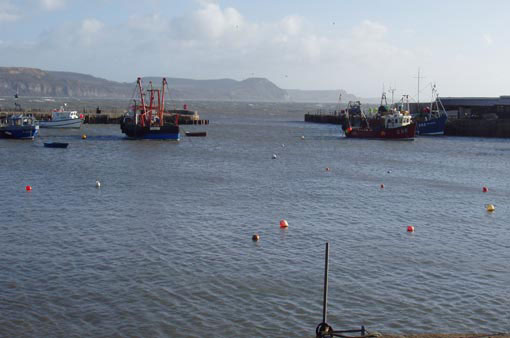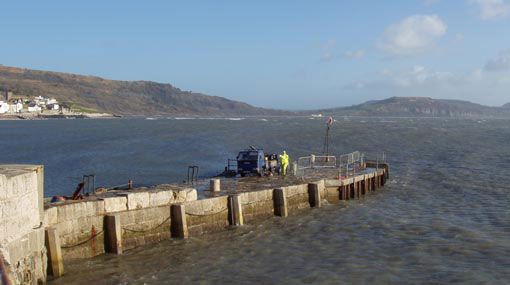
Tucked away on the south coast between Portland and Exmouth is the delightful little seaside town of Lyme Regis made famous worldwide as the setting for the film “The French Lieutenant’s Woman”, based on the novel by onetime local museum curator, the late John Fowles. With its steep hills in and out on both sides and its tiny, narrow streets, Lyme Regis has a wonderful other world feel about it. If time has not exactly stood still there, it has been a bit tardy about its movements and has no wish to be hurried along by the accelerated pace of a modern life. The railway did not come until 1903 and had closed by 1965. Even in the early 1960s when car ownership was still rare, bus services to it from Weymouth or Exeter were infrequent and any unlucky enough to miss one had a considerable wait for the next.
So far as I can see, only six paddle steamers regularly called at Lyme Regis from the 1890s to 1961, the last year a paddler called: the Duke of Devonshire, the Duchess of Devonshire, the Alexandra and the Princess Elizabeth from Torquay, the Victoria from Weymouth and, occasionally before the First World War, the Monarch from Weymouth or Bournemouth.
As you can see from the chart above, Lyme Regis is not gifted with much water at chart datum, the part shaded green drying out at the lowest of spring tides to the end of the Victoria Pier where the paddlers called. The pier is still there (November 2006) not looking much different from in its paddle steamer past.

Cosens’ Victoria was a regular visitor until 1932 on her summer coasting trip once a week from Weymouth calling at West Bay, Lyme Regis and Seaton with extensions sometimes onwards to Torquay. Note that her captain has chosen to berth his ship as far out of the harbour as he conceivably can with the paddle box on the knuckle at the end of the pier.


The Duke of Devonshire (pictured above) and her very similar sister the Duchess of Devonshire regularly sailed there from the 1890s on their services from Torquay and Exmouth along the coast calling at ports and beaches as far as Weymouth in the east and Plymouth in the west. By the 1930s their business was in decline with the Duchess withdrawn in 1931 and the Duke in 1933. The Duchess made a welcome return in private ownership in 1933 but the following summer she came to grief on the beach at Sidmouth on a day trip from Torquay and that was the end of her. The Duke returned to Torquay in 1936 and 1937 making calls roughly once a week after which she was sold to Cosens, re-named the Consul.

From 1924 to 1927 Cosens based their Alexandra at Torquay in direct competition with the local paddle steamers Duke of Devonshire and Duchess of Devonshire. With a large C painted on her funnel to distinguish her from her rivals she made cruises along the coast calling at beaches and harbours including Lyme Regis where she is pictured at rest one afternoon.


So far as I am aware, the largest paddler ever to call at Lyme Regis was Cosens’ Monarch of 1888 which made occasional trips to the port from Bournemouth and Weymouth before the First World War. At 210ft in length compared with the Victoria’s 166ft, the Alexandra’s 171ft and the Duke of Devonshire’s 175ft she would have had to stick her bow further into the harbour to get the paddle box on the knuckle at the end of the pier than the other steamers and so would have needed a higher rise of tide for her calls than her consorts.
The summers of 1960 and 1961 saw an unexpected paddle steamer revival on the Devon Coast with the arrival of the Princess Elizabeth to run non landing excursions from Torquay to the River Dart, Exmouth and Sidmouth and landing trips to Plymouth (in 1960 only) and on Thursdays in both summers to Lyme Regis. With some exceptions, the boat operators at Torquay had had a near monopoly on the local excursion business for almost twenty five years. They did not welcome this large and well appointed steamer and raised many objections to her services. At Lyme Regis, the local boatmen had initially been cooperative offering to ferry her passengers ashore at low tide when there was not enough water in the harbour for the ship to call but by the middle of August 1961 they had got in a grump because the Princess Elizabeth ran a short cruise around the bay whilst her Torquay passengers were enjoying the delights of the town and this, the boatmen said, was stealing their trade. As a result they withdrew their cooperation.
It was at this point that my parents decided to take my brother and me to Lyme Regis for a trip on this new local steamer. In she came at about 1.45pm on Thursday 17th August 1961. The Torquay passengers got off and we all got on. As usual my Dad took my brother and me down to look at the engines for departure and after they had been turning over at full astern for a while we decided to go back on deck. It came as a bit of a surprise to find that, despite all this paddle wheel thrashing astern, we were still alongside the pier. The tide had fallen away and we were aground. By 6pm the tide had risen sufficiently to float the ship, passengers were loaded and off she set for Torquay. We returned home disappointed but secretly rather pleased as Dad promised to bring us back the following Thursday when there would be no risk of a further stranding as the tide was up in the afternoon. So the grounding gave us the happy bonus of two visits to Lyme Regis instead of one.

Two weeks later, on Thursday 31st August, Princess Elizabeth stranded again. Press reports say that on the return to the harbour after the bay cruise, her approach was obstructed by some small boats causing a delay and she grounded whilst coming alongside the pier. The stern slewed round to the north and left her in an embarrassing predicament as shown in the photograph above. By 7pm the tide had come back in and off she set for Torquay once again none the worse for wear.
At first glance it is hard to understand how the Princess Elizabeth ran aground at Lyme Regis twice within a fortnight. Her master, Capt Defrates, was an experienced and competent former Cosens paddle steamer captain who was quite capable of working out the tides himself so the low tide on these two days cannot have taken him or his management by surprise. One wonders therefore just how much pressure he was under from his Guv’nor, as he always called the boss, Cdr Edmund Rhodes. We know that the short trips from Torquay had not done particularly well with all the competition and opposition from small local boats. Running costs for the paddler were high and the company was sufficiently strapped for cash that there were weeks when Capt Defrates wasn’t paid. However these trips to Lyme, which other boats from Torquay could not do, were capable of taking good dollops of the readies. A full load on a nice day could pack in the equivalent of £10K in today’s money, financial boosts which were very well worth having.

The Princess Elizabeth would have needed a rise of tide of about 2m to get alongside the Victoria Pier. Using the wonders of modern computer technology it is easy to find out that high water at Lyme Regis on August 17th 1961 was at 10.40am with low tide at 4.10pm. At 1.45pm, the ship’s arrival time, there should have been a rise of tide of 2.28m. On August 31st high water was at 11am with low water at 4.40pm with a rise of tide at 1.45pm of 2.59. So on both days there was ample water for her to get in to unload, as she did. I think that the Guv’nor would have thought this the thing to do. And if the tide went down and the ship dried out later, did that really matter? The bottom was flat and sandy, the weather was idyllic and the tide would be back in again later. OK, the passengers would be late back to Torquay but they would have had their day trip, enjoyed the delights of Lyme itself and, perhaps more importantly, the much needed revenue would have been banked.
I don’t think that Capt Defrates expected to get off for the 2pm cruise on 17th August as in fact he didn’t as the tide was predicted to fall away to 1.95m by 2.10pm. And on August 31st with the tide not predicted to fall below 2m until 2.50pm I think that, with a prompt return from the bay cruise, he hoped to get in and sit quietly alongside until the tide came back up to float him off at 7pm. Unfortunately, with the tide falling at 0.25m every ten minutes, the delay in his approach snookered that leaving the ship embarrassingly head on to the pier.
However, going aground twice was too much and future plans to call at Lyme Regis at low water were abandoned. Not that that mattered much as the company’s dispute with Torquay Corporation escalated the following week, services were withdrawn and the Princess Elizabeth retreated to Weymouth to lay up for the winter which is another story.
For 1962 the Guv’nor moved his ship to operate between Bournemouth and Swanage and from 1963 to 1965 to Weymouth to replace the Consul which had been withdrawn. He had plans to run a weekly day excursion to Lyme Regis in 1963 and leaflets were printed advertising the trips. They never happened. The harbour committee at Lyme remembered 1961 and an unpaid bill for damage to the harbour steps and weren’t enthusiastic about having the Lizzy back.
Kingswear Castle returned to service in 2023 after the first part of a major rebuild which is designed to set her up for the next 25 years running on the River Dart. The Paddle Steamer Kingswear Castle Trust is now fund raising for the second phase of the rebuild. You can read more about the rebuilds and how you can help if you can here.
John Megoran


